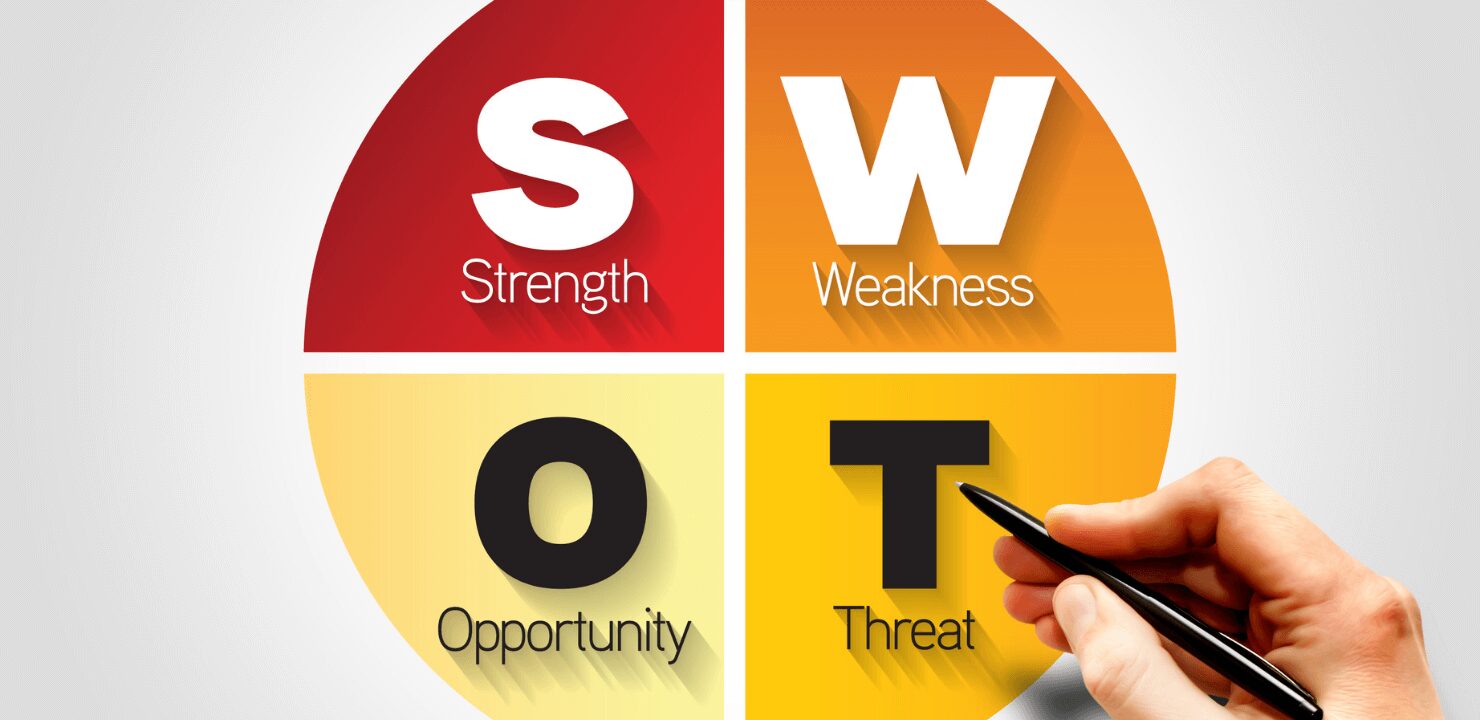
What does SWOT stand for?
S.W.O.T. stands for:
- Strengths
- Weaknesses
- Opportunities
- Threats
It’s a strategic tool businesses use to better understand their business and competition to position their company for success. By analyzing both internal and external factors, SWOT Analysis can form the foundation for business decisions and help frame your marketing to promote your business, here’s how to do it:
Conducting a SWOT Analysis
When you are undertaking a SWOT analysis, it’s helpful to include other stakeholders. Your goal is to provide an objective, honest, and accurate view of your business, so the more people participate, the more likely you are to get a fuller picture.
Work through each of the phases of the SWOT analysis and write down everything participants bring up. When you’re done, you can consolidate your list.
What are the four parts of a SWOT analysis?
Strengths
Strengths are the things your organization does well that set you apart from your competitors. Questions to ask include:
- What do we do best?
- What are we known for?
- What unique resources, assets, talent, or knowledge do we have?
- What advantages do we have?
Understanding your company’s strengths provides a base for your marketing and promotional efforts. Use these strengths to build upon. It can often lead you to uncover your unique selling proposition (USP), which is your single biggest competitive advantage. A SWOT analysis will help you learn what’s unique about what you do that you can use as a basis for your promotions.
Weaknesses
Every organization also has weaknesses. Identifying them is the first step in fixing them. Ask for total honesty from your group and avoid glossing over problems. Questions to ask include:
- What resources, assets, talent, or knowledge are we lacking?
- What disadvantages do we have?
- Where do we need to improve?
- What do others say we don’t do well?
Examining your company’s weaknesses can help you find places where you need to promote more effectively or differently.
Opportunities
Taking advantage of opportunities quickly is often the difference between average companies and highly successful ones. Spend time discussing potential opportunities for your business. Questions to ask include:
- How can we leverage our strengths to create opportunities?
- What could we do that we don’t do currently?
- How is our industry changing?
- How can we turn our weaknesses into opportunities?
Uncovering opportunities can provide insight into new markets, different approaches to promotions and marketing, and new ways of looking at things. You may discover, however, that you need to make internal changes to be ready to take advantage of these opportunities.
Threats
Threats, also consider negative external factors, can come from many places, including many outside of your control. This includes competitors, changing customer behavior, new technology, and labor shortages/costs. It’s crucial to understand these threats. Questions include:
- Are there changes in our field that could threaten our success?
- What might cause us problems in the future?
- What obstacles do we face?
- Will weaknesses prevent us from meeting our goals?
In marketing, identifying how threats might impact your promotion is crucial. It won’t do you any good to brag about your excellent customer service when your support team already has trouble staffing a call center, resulting in long wait times.
When to conduct SWOT analysis
It is recommended you conduct a SWOT analysis when:
- You want to make a business or personal decisions based on the analysis of your company’s or your own assets.
- Planning to restructure company’s policies/structure or create new ones
- Considering investment opportunities
- Expanding to a new market or reevaluating an existing one
- Creating a new marketing strategy
Analyzing Your Results
Once you’ve completed your analysis, you’ll also want to spend time discussing how you can leverage your strengths, boost weak areas, fend off potential threats, and exploit opportunities.
What are 3 major benefits of a SWOT analysis?
The benefits of conducting a SWOT Analysis include but are not limited to:
1. It helps you prevent possible threats to your business by identifying them and creating an action plan in advance.
2. It provides you with a better understanding of your business environment and the factors that influence it.
3. It can help you make decision that are based on sound reasoning and provide you with the best possible outcomes.
A SWOT analysis can help give you a clearer picture of your brand value and help you recognize opportunities. What you learn can help you make solid decisions about promoting your business. For example, when you identify strengths that line up with opportunities, it can give you a clear direction for messaging in your marketing campaigns.
As you develop future marketing campaigns, you’ll want to revisit your SWOT analysis to make sure it aligns with what you found. You’ll also want to review your SWOT framework regularly as things change quickly in business. What’s a strength today might be a weakness tomorrow — or vice versa. Get a free marketing plan with REALTOP today!
FAQs
How does SWOT analysis improve performance?
By performing a SWOT analysis, you can assess where your company currently stands and how the external environment might impact your marketing strategic planning. Once you identify the strengths, weaknesses, opportunities, and threats of your business, you will be able to optimize your marketing campaigns to make sure they provide the expected results. Whether it is allocation of extra financial resources or switching the scope of your strategy, considering the whole picture both internally and externally will help you create an accurate business strategy.
How SWOT analysis helps in decision making?
A strong SWOT analysis is a tool used to help identify possible opportunities for growth and development as well as possible risks or obstacles that could hinder progress. It can help you identify the areas you should focus on, as well as the areas you should avoid. It will not only help you to evaluate internal factors, market trends, and consumer trends, but it will also help you predict the possible results of your campaigns investment. So, if you want to make sure that your strategies will deliver the expected results, consider building a SWOT matrix for your business.
How can SWOT be used effectively?
Luckily, a SWOT analysis works in every department of a company. It can be used internally and externally. Some of the departments that would get benefited from a SWOT analysis include:
- Human resources department
- Business operations
- Marketing
- Finance
- Sales
- Leadership
If you want your whole company to remain competitive, consider implementing SWOT analysis across departments.

Nik Tsoukales, founder of REALTOP, is an experienced digital marketer with a track record of growing businesses and sales teams. He has received multiple awards for leading fast-growing companies and specializes in organic SEO, Google PPC, and Social Media. With over 89k clients acquired online, Nik’s expertise spans various industries including finance, healthcare, and real estate.









